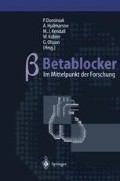Zusammenfassung
Der koronare Vasomotorentonus spielt in der Pathophysiologic der Angina pectoris eine wichtige Rolle. Eine Erhöhung des Vasomotorentonus während der sympathischen Stimulierung ist beschrieben und mit einer Abnahme des koronaren Blutflusses in Verbindung gebracht worden. Somit kann er eine Myokardischämie auslösen. Bei Patienten mit stabiler Angina pectoris ist nach intrakoronarer Verabreichung von Phentolamin [1, 2] oder Indoramin [3], eines selektiven α1-Rezeptorenblockers, über eine Verminderung der ST-Senkung mit einer Erhöhung der körperlichen Leistungsfähigkeit Berichtet worden.
Access this chapter
Tax calculation will be finalised at checkout
Purchases are for personal use only
Preview
Unable to display preview. Download preview PDF.
Literatur
Beckenboom GM, Abramowitz M, Vandermoten P (1986) S.G. D. Role of a-adrenergic coronary tone in exercise induced angina pectoris. Am J Cardiol 57: 195–198.
Gould L, Reddy GV, Gombrecht RF (1973) Oral phentolamine in angina pectoris. Jpn Heart J 14: 393–397.
Collins P, Sheridan D (1985) Improvement in angina pectoris with a-adrenoceptor blockade. Br Heart J 53: 488–492.
Whitsitt LS, Lucchesi BR (1967) Effects of propanolol and its stereoisomers upon coronary vascular resistance. Circ Res 21: 305–317.
Stephens J, Hayward R, Ead H, Adams L, Hamer J, Spurrell R (1977) Effects of selective and non-selective ß-adrenergic blockade on coronary dynamics in man assessed by rapid atrial pacing. Br Heart J 40: 856–863.
Guth BD, Heusch G, Seitelberger R, Ross JJ (1987) Mechanisms of beneficial effect of ß-adren- ergic blockade on exercise-induced myocardial ischemia in concious dogs. Circ Res 60: 738–746.
Bortone AS, Hess OM, Gaglione A, Suter T, Nonogi H, Grimm J, Krayenbuehl HP (1990) Effect of intravenous propranolol on coronary vasomotion at rest and during dynamic exer¬cise in patients with coronary artery disease. Circulation 81: 1225–1235.
Atterhog J-H, Duner H, Pernow B (1977) Hemodynamic effect of long-term treatment with pindolol in essential hypertension with special reference to the resistance and capacitance vessels of the forearm. Acta Med Scand 202: 517–521.
Brown BG, Lee AB, Bolson EL, Dodge HT (1984) Reflex constriction of significant coronary stenosis as a mechanism contributing to ischemic left ventricular dysfunction during iso- volumetric exercise. Circulation 70: 18–24.
Gage JE, Hess OM, Murakami T, Ritter M, Grimm J, Krayenbuehl HP (1986) Vasoconstriction of stenotic coronary arteries during dynamic exercise in patients with classic angina pectoris: Reversibility by nitroglycerin. Circulation 73: 865–876.
Reinwater J, Steele P, Kirch D, LeFree M, Jensen D, Vogel R (1982) Effect of propanolol on myocardial perfusion images and exercise ejection fraction in men with coronary artery disease. Circulation 65: 77–81.
Steele P, Sklar J, Kirch D, Vogel R, Rhodes CA (1983) Thallium-201 myocardial imaging during maximal and submaximal exercise with propanolol. Am Heart J 106: 1353–1357.
Schweizer J, Kaulen R, Altmann E, Nierade A, Nanning T (1996) Sind ß-Blocker bei Patienten mit peripherer arterieller Verschlufikrankheit generell kontraindiziert? Z Kardiol 85: 193–197.
Matsuzaki (1985) Effect of the combination of diltiazem and atenolol on exercise-induced regional myocardial ischemia in conscious dogs. Circulation 72: 233–243.
Yasue H, Omote S, Takizawa A, Nagao M, Miwa K, Tanaka S (1979) Exertional angina pectoris caused by coronary arterial spasm: Effects of various drugs. Am J Cardiol 43: 647–652.
Hodgson J, Cohen MD, Thames MD (1988) ß-blockade results in decreased coronary blood flow due to unopposed a-mediated vasoconstriction. J Am Coll Cardiol 11: 23A.
Wolfson S, Gorlin R (1969) Cardiovascular pharmacology of propanolol in man. Circulation 40: 501–511.
Kern MJ, Ganz P, Horowitz JD et al. (1983) Potentiation of coronary vasoconstriction by ß-adrenergic blockade in patients with coronary artery disease. Circulation 67: 1178–1185.
Heusch G, Deussen A, Thaemer V (1985) Cardiac sympathetic nerve activity and progressive vasoconstriction distal to coronary stenoses: Feed-back aggravation of myocardial ischemia. J Auton Nerv Syst 13: 311–326.
Rajfer SI, Kohli JD, Goldberg LI (1982) Contractile actions of racemic and d-propanolol on isolated canine mesenteric and coronary arteries. J Pharmacol Exp Ther 220: 127–132.
Vatner SF, Hintze TH. Mechanism of constriction of large coronary arteries by ß-adrenergic receptor blockade. Circ Res 53: 389–400.
Rafflenbeul W, Berger C, Jost S, Lichtlen P (1987) Constriction of coronary arteries and stenoses with propanolol. Circulation 76 (suppl IV): IV276.
Heusch G, Deussen A (1983) The effects of cardiac sympathetic nerve stimulation on perfu¬sion of stenotic coronary arteries in the dog. Circ Res 53: 8–15.
Gwirtz PA, Overn SP, Mass HJ, Jones CE (1986) α1-xradrenergic constriction limits coronary flow and cardiac function in running dogs. Am J Physiol 250: H1117–H1126.
Indolfi C, Piscione F, Villari B et al. (1992) Role of α2-adrenoceptors in normal and athero-sclerotic human coronary circulation. Circulation 86: 1116–1124.
Egstrup K, Anderson PE(1993) Transient myocardial ischemia during nifedipine therapy in stable angina pectoris and its relation to coronary collateral flow and comparison with meto-prolol. Am J Cardiol 71: 177–183.
Schulz W, Jost S, Kober G, Kaltenbach M (1985) Relation of antianginal efficacy of nifedipine to degree of coronary arterial narrowing and to presence of coronary collateral vessels. Am J Cardiol 55: 26–32.
Editor information
Editors and Affiliations
Rights and permissions
Copyright information
© 1997 Springer-Verlag Berlin Heidelberg
About this chapter
Cite this chapter
Julius, B., Kaufmann, P., Vassalli, G., Hess, O.M. (1997). Koronarer Vasomotorentonus: Einfluß auf die antiischämische Therapie. In: Dominiak, P., Hjalmarson, A., Kendall, M.J., Kübler, W., Olsson, G. (eds) Betablocker — im Mittelpunkt der Forschung. Springer, Berlin, Heidelberg. https://doi.org/10.1007/978-3-642-60716-5_9
Download citation
DOI: https://doi.org/10.1007/978-3-642-60716-5_9
Publisher Name: Springer, Berlin, Heidelberg
Print ISBN: 978-3-642-64522-8
Online ISBN: 978-3-642-60716-5
eBook Packages: Springer Book Archive

